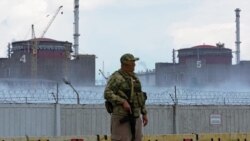Speaking at the United Nations nuclear non-proliferation conference in New York on August 1, the U.S. Secretary of State Antony Blinken called Russia’s war on Ukraine “a brazen violation of international law.”
Blinken said the United States is “deeply concerned” about the situation at the Russian-occupied Zaporizhzhia nuclear plant, the largest such facility in Europe with six reactors on the site.
“Russia is now using the plant as a military base to fire at Ukrainians, knowing that they can’t and won’t shoot back because they might accidentally strike a nuclear – a reactor or highly radioactive waste in storage. That brings the notion of having a human shield to an entirely different and horrific level,” Blinken said.
Two days later, Russia’s U.N. mission issued a rebuttal:
“We reject the unfounded accusations that Russia prevents the IAEA inspectors from visiting the Zaporizhzhia NPP and, especially, absolutely absurd speculation that a military base is allegedly being set up there.”
That is false. Credible reports say Russian troops have militarized the plant, putting up perimeter defenses, firing artillery from the grounds and effectively turning it into a base of operations shielded by the risk of a radioactive release.
Russian troops first hit the Zaporizhzhia plant in March with strikes that set buildings inside the perimeter ablaze. The fire triggered a panicked exodus of locals and set off global alarms.
Ukrainian authorities calmed the situation after putting out the fire and announcing that the reactors were safe. The United Nations’ International Atomic Energy Agency (IAEA) said a Russian “projectile” had struck a training center on the grounds.
But uncertainty mounted as Russian forces settled in. The IAEA said in May that, despite international pressure, Russia had not guaranteed safe access for inspectors to visit.
Ukraine’s nuclear safety agency said two of Zaporizhzhia’s reactors were operational, but that the agency is “no longer in a position to oversee nuclear safety at the site.” Ukraine’s personnel are keeping the plant safe “under extremely stressful conditions,” said the Nuclear Energy Agency, an arm of the Organization for Economic Co-operation and Development.
On July 5, The Wall Street Journal reported:
“At the Zaporizhzhia Nuclear Power Plant in southern Ukraine, more than 500 Russian soldiers who seized the facility in March recently have deployed heavy artillery batteries and laid anti-personnel mines along the shores of the reservoir whose water cools its six reactors, according to workers, residents, Ukrainian officials, and diplomats.”
In mid-July, the chairman of Ukraine’s nuclear operator, Energoatom, said the Russians had deployed and used missile launchers on the plant site.
Since then, Russia has been launching artillery rounds from the plant site across the Dnipro River into the west-bank town of Nikopol, The New York Times reported on August 1:
“The Russians have been firing from the cover of the Zaporizhzhia station since mid-July, Ukrainian military and civilian officials said, sending rockets over the river at Nikopol and other targets.
“It is, in effect, a free shot. Ukraine cannot unleash volleys of shells in return using American-provided advanced rocket systems, which have silenced Russian guns elsewhere on the front line. Doing so would risk striking one of the six pressurized water reactors or highly radioactive waste in storage. And Russia knows it.
“‘They are hiding there so they cannot be hit,’” said Oleksandr Sayuk, the mayor of Nikopol. ‘Why else would they be at the electrical station? To use such an object as a shield is very dangerous.’ ”
Ukraine said on August 4 that Russian strikes originating from the Zaporizhzhia plant damaged 50 residential buildings in Nikopol.
A day earlier, IAEA Director General Rafael Grossi told The Associated Press: “Every principle of nuclear safety has been violated” at the Zaporizhzhia nuclear plant, and the situation is “completely out of control.”






